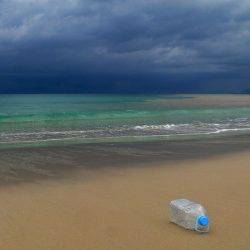 A few years ago, the most commonly recognised symbol of humankind’s impact on the environment was the image of a solitary polar bear, adrift on a rapidly shrinking ice floe. Google a term like ‘melting ice caps’ even now, and you’ll still derive a host of variations of the same meme. More recently a new and even more unpleasant series of symbols has emerged for a similarly environmentally catastrophic phenomenon, carried worldwide on the tide of social media. This time, they are not about the way we pollute the atmosphere but also the land and seas, particularly with plastic. Social media feeds are packed with images of the corpses of seabirds, their flesh rotted away to expose the amount of plastic they have consumed. This is the new face of environmental disaster. This is not just an issue that affects birds, however. Barely a day passes when we cannot see a new image of turtles malformed after getting caught up in plastic netting or six pack rings, whales beached after choking on dozens of discarded plastic bags they’ve mistaken for food, clogged waterways and oceans, piles of rubbish and beaches that consist in large part of plastic eroded to the size of sand grains. Most recently Sky ran a heartbreaking documentary about a whale that had died with a stomach full of plastic rubbish.
A few years ago, the most commonly recognised symbol of humankind’s impact on the environment was the image of a solitary polar bear, adrift on a rapidly shrinking ice floe. Google a term like ‘melting ice caps’ even now, and you’ll still derive a host of variations of the same meme. More recently a new and even more unpleasant series of symbols has emerged for a similarly environmentally catastrophic phenomenon, carried worldwide on the tide of social media. This time, they are not about the way we pollute the atmosphere but also the land and seas, particularly with plastic. Social media feeds are packed with images of the corpses of seabirds, their flesh rotted away to expose the amount of plastic they have consumed. This is the new face of environmental disaster. This is not just an issue that affects birds, however. Barely a day passes when we cannot see a new image of turtles malformed after getting caught up in plastic netting or six pack rings, whales beached after choking on dozens of discarded plastic bags they’ve mistaken for food, clogged waterways and oceans, piles of rubbish and beaches that consist in large part of plastic eroded to the size of sand grains. Most recently Sky ran a heartbreaking documentary about a whale that had died with a stomach full of plastic rubbish.
A recent story in The Guardian identified the world’s most plastic polluted place as a formerly idyllic but deserted coral atoll in the South Pacific. According to researchers from the University of Tasmania, there are an estimated 671 pieces of plastic debris per square metre on the tiny, uninhabited island. The amount of waste in the environment has become so great that the place has become a tip through the passive accumulation of rubbish.
This may be at the extreme but the truth is that the world is clogging up with its own discarded plastic. This is despite the fact that some of the most common sources of this waste are made from ostensibly recyclable materials. The reason why simply using this kind of material is not the sole answer is down not only to the volume of plastic we use – Greenpeace estimates that Coke alone sells up to 128 billion single-use plastic bottles each year – but also to two complicating and interrelated factors; the design of products and the way they are managed though their life cycle.
The issue was highlighted by the CEO of the Recycling Association Simon Ellin in a recent interview with the BBC, which you can see here. Ellin highlighted a number of products that were let down by their design, and not just their materials. He singled out Pringles and Lucozade as among the worst offenders. The sheer mix of materials in Pringles tubes makes them a problem with a cardboard outer, metal lining, metal base, foil and paper strip and plastic lid. Similarly Lucozade Sport bottles use a polymer shrink wrap sleeve that makes them impossible to recycle, regardless of the materials they use. They carry the recycling symbol all the way to landfill and the environment.
“We have got to ensure that the whole supply chain is involved from designers, to manufacturers, to retailers, to recyclers, to local authorities and the householder so that the products we buy can be recycled,” he said in the interview.
Although his criticism is aimed primarily at the most recognised consumer products, the underlying principle is applicable to all products. His argument that it’s no longer enough to consider the materials used in products unless we also address their supply chains and life cycles is just as important for business to business products as it is any other sector. This means becoming more informed about the issues and for firms to ask more difficult questions of their suppliers.
Of course, there is a theory that when companies talk about issues such as this they are doing so because it helps them to achieve their business goals and tend to meet only the minimum standards required of them by the law and the need to win work. This is the coldly rational thing to do according to people like free market guru Milton Friedman who argues that companies should not actively pursue altruistic ends unless that pursuit is ultimately in the interest of their shareholders. As Friedman puts it: ‘Hypocrisy is virtuous when it serves the bottom line. Moral virtue is immoral when it does not’.
This is not only cynical but does not explain why so many companies do more than they need to and are often ahead of the demands of their customers. The reason for that is that they are managed by people with many of the same concerns about the environment as everybody else. That is why a growing number of manufacturers have developed a sophisticated approach to the design of their products that touches not only on the end product itself but on every aspect of the firm’s operations, back through the supply chain and to the recycling, refurbishment, reuse and ethical disposal of the product.
We all have an interest in understanding this core principle and to address the issues of design and management of products that make it so important for the future of the planet. It is no longer enough to think of this as a problem that is solely about materials. We are horrified by the images of dead animals choked and poisoned by the things we throw away, but the answers lie in both the amount of stuff we discard and also the processes that mean they end up back in the world. That is the bigger picture.
__________________________________________
 Michael Tyerman is the head of international sales at Woven Image.
Michael Tyerman is the head of international sales at Woven Image.












June 30, 2017
Why using recyclable materials is no longer enough to protect the environment 0
by Michael Tyerman • Comment, Environment, Workplace design
A recent story in The Guardian identified the world’s most plastic polluted place as a formerly idyllic but deserted coral atoll in the South Pacific. According to researchers from the University of Tasmania, there are an estimated 671 pieces of plastic debris per square metre on the tiny, uninhabited island. The amount of waste in the environment has become so great that the place has become a tip through the passive accumulation of rubbish.
This may be at the extreme but the truth is that the world is clogging up with its own discarded plastic. This is despite the fact that some of the most common sources of this waste are made from ostensibly recyclable materials. The reason why simply using this kind of material is not the sole answer is down not only to the volume of plastic we use – Greenpeace estimates that Coke alone sells up to 128 billion single-use plastic bottles each year – but also to two complicating and interrelated factors; the design of products and the way they are managed though their life cycle.
The issue was highlighted by the CEO of the Recycling Association Simon Ellin in a recent interview with the BBC, which you can see here. Ellin highlighted a number of products that were let down by their design, and not just their materials. He singled out Pringles and Lucozade as among the worst offenders. The sheer mix of materials in Pringles tubes makes them a problem with a cardboard outer, metal lining, metal base, foil and paper strip and plastic lid. Similarly Lucozade Sport bottles use a polymer shrink wrap sleeve that makes them impossible to recycle, regardless of the materials they use. They carry the recycling symbol all the way to landfill and the environment.
“We have got to ensure that the whole supply chain is involved from designers, to manufacturers, to retailers, to recyclers, to local authorities and the householder so that the products we buy can be recycled,” he said in the interview.
Although his criticism is aimed primarily at the most recognised consumer products, the underlying principle is applicable to all products. His argument that it’s no longer enough to consider the materials used in products unless we also address their supply chains and life cycles is just as important for business to business products as it is any other sector. This means becoming more informed about the issues and for firms to ask more difficult questions of their suppliers.
Of course, there is a theory that when companies talk about issues such as this they are doing so because it helps them to achieve their business goals and tend to meet only the minimum standards required of them by the law and the need to win work. This is the coldly rational thing to do according to people like free market guru Milton Friedman who argues that companies should not actively pursue altruistic ends unless that pursuit is ultimately in the interest of their shareholders. As Friedman puts it: ‘Hypocrisy is virtuous when it serves the bottom line. Moral virtue is immoral when it does not’.
This is not only cynical but does not explain why so many companies do more than they need to and are often ahead of the demands of their customers. The reason for that is that they are managed by people with many of the same concerns about the environment as everybody else. That is why a growing number of manufacturers have developed a sophisticated approach to the design of their products that touches not only on the end product itself but on every aspect of the firm’s operations, back through the supply chain and to the recycling, refurbishment, reuse and ethical disposal of the product.
We all have an interest in understanding this core principle and to address the issues of design and management of products that make it so important for the future of the planet. It is no longer enough to think of this as a problem that is solely about materials. We are horrified by the images of dead animals choked and poisoned by the things we throw away, but the answers lie in both the amount of stuff we discard and also the processes that mean they end up back in the world. That is the bigger picture.
__________________________________________